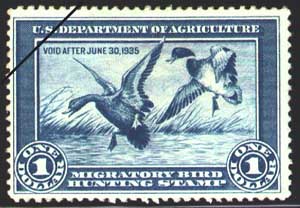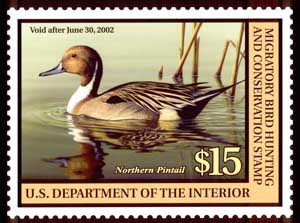
have practical origin Once the North American continent teemed with wild ducks, geese, swans, and other water birds. Native Americans and early European settlers hunted the plentiful birds, taking only what they needed to feed themselves and their families. Times have changed, however. The expanding U.S. population has meant trouble for waterfowl and other wildlife. People have leveled forests, plowed prairies, dammed rivers and, most importantly, drained wetlands to make way for man's houses, factories, roads, farms, and shopping centers. Millions of acres of pristine habitat that waterfowl need to survive have been lost. The decline of waterfowl was accentuated during the 1800s and early this century by overeager hunters and a commercial demand for meat and feathers. Market hunters decimated great flocks and some individual species were so reduced in numbers as to be in danger of extinction. Compounding these man-made problems, periodic drought dried up the prairie potholes, northern bogs and southern swamps used by waterfowl for food and habitat. The infamous "dust bowl" of the 1930s, in particular, left many formerly lush wetlands dry and lifeless. By the late 1920s, a number of American conservationists, hunters, and government officials had become alarmed at the prospect of losing some of our waterfowl species. The first positive step towards preventing that was passage of the Migratory Bird Conservation Act in 1929. It authorized the Department of the Agriculture to acquire wetlands and to preserve them as waterfowl habitat. The law also established a commission of federal and state officials to evaluate land for possible acquisition. The Migratory Bird Conservation Act of 1929 was the first step in securing waterfowl habitat but it provided no permanent source of money with which to buy and preserve land for waterfowl. That omission was soon corrected by Jay N. Darling, a nationally known political cartoonist for the Des Moines Register. Also a noted hunter and wildlife conservationist, "Ding" Darling had often put his artistic talents into biting cartoons depicting the destruction of the nation's waterfowl and their habitats. President Franklin D. Roosevelt had appointed Darling in 1934 as chief of the Bureau of Biological Survey, a predecessor of the U.S. Fish and Wildlife Service. In that position, Darling was instrumental in the conception and development of a stamp to be bought by all waterfowl hunters that would generate funds to pay for acquiring and preserving habitat for ducks, geese and swans. On March 16, 1934, Congress passed and President Roosevelt signed the Migratory Bird Hunting Stamp Act. Popularly known as the Duck Stamp Act, it required all waterfowl hunters 16 years or older to buy a stamp annually. The revenue generated was earmarked for the Department of the Agriculture, and then five years later transferred the authority to the Department of Interior and the U.S. Fish and Wildlife Service to buy or lease waterfowl sanctuaries. In the years since its enactment, the Federal Duck Stamp Program has become one of the most popular and successful conservation programs ever initiated. Some 635,000 hunters paid $1 each for the first stamps, which went on sale August 22, 1934. Since then, the price has gradually risen to the current $15 and the number of stamps bought climbed to a peak of 2.4 million in 1970-71. Today, some 1.5 million stamps are sold each year. Not only waterfowl hunters buy Duck Stamps; they have become popular with stamp collectors as well. A collector who had bought each stamp the year it was issued would have paid a total of $304 by 1996. That investment would now be worth well over $5,000. Stamps issued before 1941 are exceedingly rare since the law originally specified that unsold stamps were to be destroyed the following year. Although the majority of excess stamps are still destroyed annually, the U.S. Fish and Wildlife Service, which administers the Federal Duck Stamp Program, as well as the U.S. Postal Service, continue to sell each year's stamp for three years. More importantly, as of 1995, Federal Duck Stamps have generated $501 million that has been used to preserve 4,389,792.86 acres of waterfowl habitat in the United States. Many of the more than 510 national wildlife refuges have been paid for all or in part by Duck Stamp money. But waterfowl are not the only wildlife to benefit from Federal Duck Stamps. Numerous other birds, mammals, fish, reptiles and amphibians have similarly prospered because of habitat protection made possible by the program. Further, an estimated one third of the nation's endangered and threatened species find food or shelter in refuges preserved by Duck Stamp funds. Not only wildlife, but people, too, have benefited from the Federal Duck Stamp Program. Hunters are ensured birds for their bag, and other outdoor enthusiasts gain places to hike, birdwatch or merely visit. Moreover, the protected wetlands help dissipate storms, purify water supplies, store flood water, nourish fish hatchlings important for sport and commercial fishermen. The first Federal Duck Stamp, designed by "Ding" Darling himself at President Roosevelt's request, depicts two mallards about to land on a marsh pond, and must measure 10" wide by 7" high. Federal Duck Stamps may be purchased from the Federal Duck Stamp Office (DSO) in Washington, D.C., any U.S. Post Office, various sporting goods stores (including many KMart and Wal-Mart stores), and most national wildlife refuges. Additional information is available by writing the Federal Duck Stamp Office, U.S. Fish and Wildlife Service, 1849 C Street NW, Suite 2058, Washington, D.C. 20240, or calling (202) 208-4354, or on the internet at http://duckstamps.fws.gov/. |

